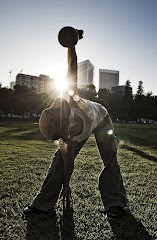What it isn't:
Just pushing some weight overhead. Easily, repetitively. While chatting about American Idol.
It also isn't the military press machine at the gym. Select your weight, sit down, and push the handles up however many times. The only thing you're thinking about is where to put the pin.
What it IS:
Learning how to firmly wedge yourself between the earth and the object (kettlebell). (Notice the word "learning" there: Hardstyle ALSO means you never stop learning how to do it
better.)
The other important concepts there: firmly, earth, and object.
Firmly: This is strength. Linkage. Compression. Alignment.
Earth: A large immovable sphere, that you want to actually be in contact with (not buffered by cushy shoes, or big, blowup yoga balls).
Object: Hardstyle kettlebell training isn't about the kettlebell... Hardstyle concepts are principles of strength and resilience, not principles of the preferred tool used to practice them.
The concept of pushing yourself away from the kettlebell/object, of pushing into the ground, is difficult for many newer gireviks - they often say, well you can't
actually push the ground away, so, WTH?
As a response, consider:
You have to press something somewhat heavy overhead, while sitting. Or even perform a bicep curl. I don't care. You have the option of sitting either: on the ground, or on an inflatable chair in a swimming pool. Something instinctively tells you that you'll have more success pushing "against" the harder surface rather than the squishy one, right?
Or consider:
A very short ceiling.
So short, in fact, that you've had to cut a hole out of it for the top of your head to stick through. But, you decide you really don't like having your head stuck through this very short ceiling. So, let's try making some room. Push up the ceiling. Will you want squishy shoes on? Or shoes with an elevated heel (both of which are common in most athletic shoes)? No, you'll probably ditch the shoes and opt to push right through your feet, through your arches and heels, into the floor - and that intuition would be correct.
Then what? If you are REALLY determined to push that ceiling up, you'll get your hips right over your feet, and your shoulders right over your hips, and push straight up (and down!) through them. Then you've got to "get tight." Use your muscles to strengthen that position against pressure. If you don't, then as soon as you start pushing, you'll push some body part around, instead - like, your hips will tilt and you'll put some wicked nice pressure right into your spine. That is energy leakage - that is injury - and that is a ceiling that is still too dang short. I mean sure, you can just start pushing... but your body will break before the ceiling will. Alignment and proper core strength (and the requisite shoulder/thoracic mobility) will let you feel yourself push right into your feet - not into your neck or back - whether or NOT the ceiling gives way.
What we have is two sources of pressure, from above and below - the earth and the ceiling - putting opposing force on your body. Obviously, the earth will win against your brute strength every time. How can we put up a fight against the ceiling? Alignment. Let our bones act like the perfect supportive structures they are, and wedge ourselves under it.
Imagine a baseball bat in a vice, pressure perfectly applied at opposing ends. If that bat has been cracked in the middle, you might actually be able to snap the thing. That crack can be knees that aren't locked, hips that aren't extended, or loose muscles holding that position in place. A hardstyle military press teaches you how to be the baseball bat without a crack in the middle. It teaches you how to exert force on the other object(s), without letting your body absorb (suffer) any of that energy or pressure. Your body has to transmit that energy right into the earth and back again (since we're not going to be moving the earth).
So, when this wedge has been achieved, the kettlebell (ceiling) goes up. It is just not in any way a matter of how strong your arms are, or how big your muscles are. It's how well you've practiced hardstyle principles. It's a whole-body thing. It's mobility, alignment, compression and tension. It's a healthy, happy back. It's a neck that doesn't try to do too much. All these things together make a strong body, and when we say you've got a strong military press, that's exactly what we mean.




